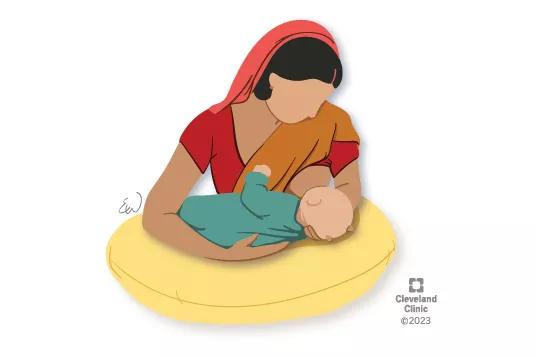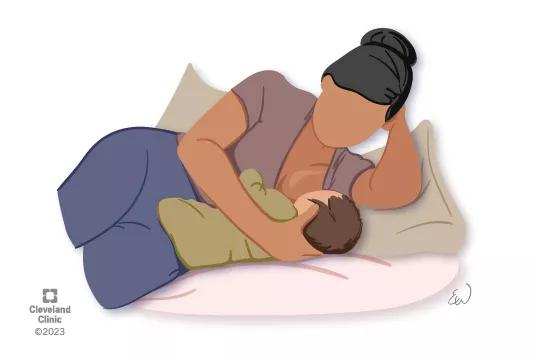From the football hold to the cradle hold, consider trying a variety of techniques

You’ve just had a baby. It’s an exciting time full of new memories.
Advertisement
Cleveland Clinic is a non-profit academic medical center. Advertising on our site helps support our mission. We do not endorse non-Cleveland Clinic products or services. Policy
And the time spent between you and your child while breastfeeding or chestfeeding can be one of the most intimate experiences. In addition to bonding, you’re providing vital nutrients for your child’s growth and development.
But there isn’t a one-size-fits-all way of breastfeeding your child. The best breastfeeding positions are the ones that work for you and your baby.
Certified nurse midwife Jessica Costa, APRN, CNM, explains why it’s important to have a few different breastfeeding positions in your routine.
Here are some common breastfeeding positions to try:

The laid-back breastfeeding position is also known as biological nurturing. Start by leaning back on your bed or couch into a semi-reclined position. Place your baby tummy to tummy on your body so their head is near your breast.
“This is a newer position that people have used over the last several years,” says Costa. “It’s going to be more comfortable for baby and feel more natural. Babies are able to relax in this position.”
This position seems to promote a baby’s feeding instincts the best. This position has also been shown to improve your baby’s latch and decrease nipple trauma and discomfort. Research also shows that laid-back breastfeeding is good if you have a strong letdown or oversupply, as it slows the flow of milk.
Advertisement
If you had a cesarean delivery (C-section), using the laid-back position is ideal, Costa adds.
“You don’t have to be completely upright, which can cause more pain and discomfort at the incision site,” she continues. “And with the laid-back position, you use less of your abdominal muscle, so it will help with pain relief.”
This is also one of a few good breastfeeding positions for reflux — or if your baby tends to spit up a lot. And upright breastfeeding positions like laid-back breastfeeding and cradle hold are also good if your child is frequently gassy.

The cradle hold is the most common position, as it gives you the most control.
Start in an upright position. Place your baby across your chest so their head rests in the nook of your elbow on the side that you’ll be breastfeeding. Use your other arm to support the rest of your baby’s body and place your hand on your baby’s upper back to gently push your baby closer to your body.
“What’s happening is your baby is actually putting its weight onto you,” explains Costa. “While it’s similar to laid-back breastfeeding where you’re laying back into a seated position, in the cradle position, you’re sitting up straight and cradling the baby. The baby is not actually laying onto your chest.”

Start in an upright position, preferably in a chair with armrests. Place your baby across your chest using your arm opposite the breast you’re feeding from. (For your right breast, use your left arm; for your left breast, use your right arm.) Make sure to support your baby’s head with your hand. Your other hand can be used to support your breast from the underside. It can be very helpful to lay a pillow across your lap for added support.
“The cross-cradle is essentially the same thing as cradle, but instead of holding your baby in the nook of your elbow, you’re actually bringing the opposite arm and holding the baby’s head,” says Costa. “It gives you a little more control of the baby’s head versus a cradle. With the cross-cradle, you’re able to manipulate baby’s head into position and can move it a little more easily.”
This position is helpful for some babies who struggle to latch deeply and benefit from very direct guidance to the breast.

The football breastfeeding position is also known as the underarm or clutch hold. Face your baby toward your breast and place them beside you with your elbow bent. Your baby’s body will rest on your forearm. Make sure to use your hand to support your baby’s head. You can use your free hand to support your breast if needed.
Advertisement
“The football hold is nice because it drains the breast in a different direction,” notes Costa. “Some babies might latch better in that position and can be more relaxed.”
This hold often also works well when you want to keep your baby’s weight off a Cesarean incision or if you have larger breasts.
You’ll also need a pillow or some kind of support with this position.
“I also recommend a pillow for all other positions as well, especially while babies are so little,” she adds. “It’s a lot of effort for the parent to hold them and do everything. So, it’s really good in any position to have a pillow to help support your baby.”

The side-lying breastfeeding position requires you to lie on your side and have your baby face you — tummy to tummy. Use the arm you’re not lying on to support your baby and cup your breast if needed.
“This is beneficial for parents who want to get some rest or if you have to breastfeed in the middle of the night,” says Costa. “You want to make sure that you’re able to be awake and alert and not fall asleep with your baby in that position before you attempt it.”
This is often a good position if you have a strong milk letdown or an oversupply of milk because it slows down the milk flow.
Advertisement
There’s been some criticism that breastfeeding positions such as the side-lying position can cause ear infections. But Costa says that while some research indicates upright positions reduce ear infections, more research needs to be done.

Start in an upright position. Have your baby straddle your thigh or place them on your hip. You want their spine and head to be upright as they feed.
“This position is going to be more for an older baby,” clarifies Costa. “It’s an easy position to use when you’re out as your child gets older and they can hold their head up.”
This position is also good if you are in a wheelchair or have other mobility issues.

Have more than one baby? You can opt to breastfeed them independently. But you can also use the football hold with one baby on each side. Make sure you support both of their heads and use pillows for support.
You’ve found a breastfeeding position that works for you. But don’t overlook trying out a few different positions through the course of feeding your child.
“Different breastfeeding positions empty the breast in different ways,” says Costa. “Different feeding positions also assist the baby in being able to latch in a different position.”
So, if your little one is having trouble latching, switching to another position may make it easier to get a better latch. “They’ll be able to empty the breast more freely,” she adds.
Advertisement
Additionally, if you have a strong letdown or oversupply, or your baby has reflux, some positions are recommended over other positions.
It’s also important to pay attention to the early feeding cues from your child like:
“Work on understanding early feeding cues so your baby doesn’t get worked up and cry because then latching isn’t going to go well and your baby’s not going to want to breastfeed right away,” advises Costa. “Allow your baby to take in as much of your areola as possible and not just latch onto the nipple. As your baby opens wide, bring your baby’s chin in to the breast first.”
But what about if your breasts are small or on the larger side?
“It’s all personal preference,” she says. “It’s going to depend on the size of the baby and your breast size. I recommend parents try all positions to see what works best for them.”
Costa adds that those with larger breasts should hold on to their breast while feeding their baby.
“Don’t just let it go,” she urges. “The weight of the breast is going to be harder for baby to keep in their mouth.”
Plenty of new parents struggle with breastfeeding.
The biggest tip? Remember to breathe, encourages Costa. “You want to make sure that you’re calm and that you keep your baby calm.”
She also recommends taking a breastfeeding class prior to delivery.
“Breastfeeding can be very overwhelming. It’s so much information,” she recognizes. “So, to be able to be prepared and have some basic understanding before having your little one can be very helpful.”
If you’ve tried different positions and still have no success, Costa advises reaching out to a lactation consultant. “A lactation consultant will see if there’s anything that is anatomically not working with you or your baby.”
And remember, you’re not alone in your breastfeeding journey.
“Breastfeeding can cause a lot of depression for people who can’t feed their babies,” she empathizes. “There’s help out there. You’re not alone.”
Learn more about our editorial process.
Advertisement

When breastfeeding doesn’t go as planned, you may need to supplement with formula or donor breast milk — and that’s OK

Breastfeeding supplements can be a needless expense at best, and risky at worst

Typically, milk comes in a few days after birth and regulates around four weeks after delivery

Gentle massaging, lying on your side and hand-expressing a little milk can help

Get your milk flowing by getting comfy, releasing stress and focusing on your baby

Popular myth says breastfeeding prevents pregnancy, but that’s not the whole story

With some exceptions, most are OK

Removing the piercing as early as possible is important for avoiding complications

Type 2 diabetes isn’t inevitable with these dietary changes

Applying a hot or cold compress can help with pain